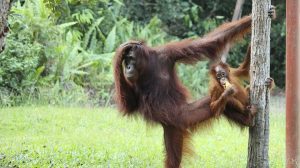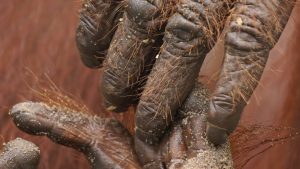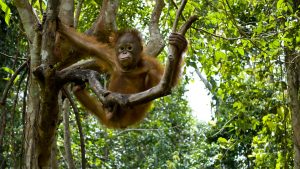Orangutan Facts
 Where do orangutans live? How many species of orangutan are there? What do orangutans eat? Are orangutans strong? Why are the main threats to orangutans? Find fun facts and answers to all your questions here!
Where do orangutans live? How many species of orangutan are there? What do orangutans eat? Are orangutans strong? Why are the main threats to orangutans? Find fun facts and answers to all your questions here!
Orangutan Behaviour
 Social organisation, male-male competition, life history, life in the trees, nest building, tool use, and culture: Orangutans are a semi-solitary species with very slow life histories. They travel, eat, and sleep in the forest canopy, making a new sleeping nest most nights. Orangutans have a high level of intelligence which manifests itself in tool-use and the making of tools in the wild. Orangutans exhibit many socially learned traditions that are passed down from generation to generation.
Social organisation, male-male competition, life history, life in the trees, nest building, tool use, and culture: Orangutans are a semi-solitary species with very slow life histories. They travel, eat, and sleep in the forest canopy, making a new sleeping nest most nights. Orangutans have a high level of intelligence which manifests itself in tool-use and the making of tools in the wild. Orangutans exhibit many socially learned traditions that are passed down from generation to generation.
Orangutan Biology
 Taxonomy, morphology, growth and evolution: There are three species of orangutans commonly known as the Bornean orangutan (Pongo pygmaeus), Sumatran orangutan (Pongo abelii) and the recently discovered Tapanuli orangutan (Pongo tapanuliensis). They are the largest arboreal animals in the world and their bodies are adapted to eat, sleep, and move in the forest canopy. It is probable that orangutans diverged from the human lineage between about 12 and 15 million years ago.
Taxonomy, morphology, growth and evolution: There are three species of orangutans commonly known as the Bornean orangutan (Pongo pygmaeus), Sumatran orangutan (Pongo abelii) and the recently discovered Tapanuli orangutan (Pongo tapanuliensis). They are the largest arboreal animals in the world and their bodies are adapted to eat, sleep, and move in the forest canopy. It is probable that orangutans diverged from the human lineage between about 12 and 15 million years ago.
Orangutan Ecology
 Geographical range, habitat and diet: Orangutans are currently found only on the islands of Borneo and Sumatra with the Sumatran species limited to the northern part of the island. Orangutans on both islands are mostly found in peat swamp forests, tropical heath forests, and mixed dipterocarp forests. Orangutans eat ripe fruit, along with young leaves, bark, flowers, honey, insects, vines, and the inner shoots of plants.
Geographical range, habitat and diet: Orangutans are currently found only on the islands of Borneo and Sumatra with the Sumatran species limited to the northern part of the island. Orangutans on both islands are mostly found in peat swamp forests, tropical heath forests, and mixed dipterocarp forests. Orangutans eat ripe fruit, along with young leaves, bark, flowers, honey, insects, vines, and the inner shoots of plants.
Orangutan Conservation
 The primary factor causing the decline of orangutan populations is the destruction and degradation of their tropical rain forest habitats. Human activities and development, such as logging, conversion of forest to palm oil plantations, mining, and urban expansion, are the major contributors to the loss of orangutan habitat.
The primary factor causing the decline of orangutan populations is the destruction and degradation of their tropical rain forest habitats. Human activities and development, such as logging, conversion of forest to palm oil plantations, mining, and urban expansion, are the major contributors to the loss of orangutan habitat.
